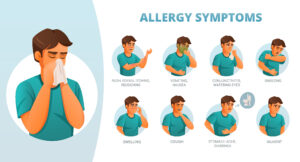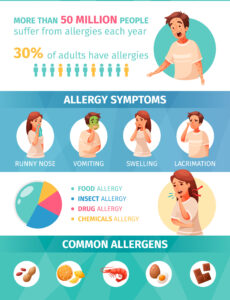Allergy
An allergy is an abnormal and exaggerated immune response to substances that are usually harmless to most people. These substances, known as allergens, trigger the immune system to produce antibodies (such as IgE) and release chemicals, such as histamine, in an attempt to defend the body. The release of these chemicals leads to various allergic reactions, which can range from mild to severe.

Common allergens include pollen, dust mites, pet dander, certain foods (e.g., nuts, eggs, shellfish), insect stings, mold spores, and certain medications.
Allergic reactions can manifest in various ways, including:
1. Respiratory symptoms: Sneezing, runny or stuffy nose, coughing, wheezing, shortness of breath, and asthma exacerbations.
2. Skin reactions: Itching, hives (urticaria), eczema, or swelling.
3. Gastrointestinal symptoms: Nausea, vomiting, diarrhea, or abdominal pain.
4. Anaphylaxis: A severe and potentially life-threatening reaction that affects the whole body, leading to difficulty breathing, rapid drop in blood pressure, and loss of consciousness.
Management of allergies involves several approaches, depending on the type and severity of the allergy. Here are some general strategies for managing allergies:
1. Avoidance: Identify the allergens that trigger your symptoms and take steps to avoid or minimize exposure to them. For example, keeping your living space clean and free of dust, using air purifiers, and avoiding certain foods.
2. Medications: Over-the-counter or prescription medications can help alleviate allergy symptoms. Antihistamines, decongestants, nasal corticosteroids, and eye drops are some of the commonly used medications.
3. Immunotherapy: Allergy shots (subcutaneous immunotherapy) or allergy tablets/sublingual drops (sublingual immunotherapy) are effective for some people with allergies. These treatments gradually expose the immune system to small amounts of the allergen, helping the body build tolerance over time.
4. Emergency Action Plan: If you have a severe allergy that can lead to anaphylaxis (e.g., food, insect sting), it's essential to have an emergency action plan and carry an epinephrine auto-injector (e.g., EpiPen) with you at all times.
5. Consult an Allergist: If you experience persistent or severe allergy symptoms, it's crucial to consult an allergist/immunologist. They can help identify the specific allergens affecting you and recommend a tailored management plan.
6. Dietary Management: For individuals with food allergies, strict avoidance of the allergenic food is crucial. Reading food labels carefully and being cautious when eating out can be essential to prevent accidental exposure.
Remember, managing allergies is a lifelong process, and it's essential to work with healthcare professionals to find the most effective strategies for your specific allergies. Additionally, in case of severe allergies or anaphylaxis, always seek immediate medical attention.
Skin Prick Test
Immunotherapy
Immunotherapy, also known as allergy shots or allergen immunotherapy, is a type of treatment designed to modify the body's immune response to allergens. The aim of immunotherapy is not necessarily to switch off the allergic response entirely but to reduce its severity and provide long-term relief from allergy symptoms. This treatment is particularly beneficial for individuals with severe allergies who do not respond well to medication or want a more sustainable solution beyond symptom management.
Here's how immunotherapy works:
1. Identification of allergens: First, an allergist will conduct tests to identify the specific allergens triggering the allergic response in the individual. Common allergens include pollen, dust mites, pet dander, mold spores, and certain insect venoms.
2. Preparation of allergen extracts: Commercially prepared extracts of the identified allergens are then created. These extracts contain small amounts of the allergen and are used for the immunotherapy treatment.
3. Gradual exposure: The immunotherapy treatment involves administering regular doses of the allergen extracts to the person, usually through subcutaneous injections (allergy shots) or sublingual tablets/drops placed under the tongue.
4. Desensitization and tolerance: Over time, the person's immune system becomes desensitized to the allergens as it gradually gets used to their presence. The immune system starts to tolerate the allergens, reducing the severity of the allergic response.
5. Symptom reduction: As the immune system becomes less reactive to the allergens, allergy symptoms diminish or become milder. This can provide significant relief for people who suffer from seasonal or year-round allergies.
It is essential to note that immunotherapy is not a quick-fix solution and typically requires several months to years of treatment to achieve the desired results. Additionally, not everyone is a suitable candidate for immunotherapy, and its effectiveness varies from person to person.
While medication, such as antihistamines and corticosteroids, can help manage allergy symptoms, they do not alter the underlying immune response to allergens. Immunotherapy, on the other hand, attempts to modify the immune system's response, providing a potentially longer-lasting and more natural way to manage allergies.
As with any medical treatment, immunotherapy should be carried out under the guidance of a qualified allergist or immunologist to ensure safety and effectiveness. If you or someone you know is considering immunotherapy, it's essential to consult with a healthcare professional to determine the most suitable approach for managing allergies.
Common Allergen
The most common allergens vary depending on geographical location, climate, and individual sensitivities. However, some allergens are widespread and tend to cause allergic reactions in a significant portion of the population. Here are some of the most common allergens:

1. Pollen: Pollen from trees, grasses, and weeds is a common trigger for seasonal allergies (hay fever or allergic rhinitis). Different types of trees, grasses, and weeds release pollen at different times of the year, leading to seasonal allergies in many people.
2. Dust Mites: Dust mites are tiny creatures that thrive in warm and humid environments. They are a common trigger for indoor allergies and are typically found in bedding, upholstered furniture, carpets, and curtains.
3. Pet Dander: Proteins found in the skin cells, saliva, and urine of pets (such as cats and dogs) can trigger allergic reactions in some individuals.
4. Mold Spores: Mold spores are airborne and can be found both indoors and outdoors. They are more prevalent in damp and humid environments, such as bathrooms, basements, and areas affected by water damage.
5. Insect Sting Venom: Allergic reactions to insect stings from bees, wasps, hornets, and fire ants can be severe and, in some cases, life-threatening.
6. Foods: Common food allergens include peanuts, tree nuts (e.g., almonds, walnuts), eggs, milk, soy, wheat, fish, and shellfish. Food allergies can cause a range of symptoms, from mild to severe, and some can be life-threatening.
7. Medications: Certain medications, such as penicillin and other antibiotics, can trigger allergic reactions in susceptible individuals.
8. Latex: Latex is a type of rubber found in many products, including gloves, balloons, and medical devices. Latex allergies can be a concern, particularly for healthcare workers and individuals with repeated exposure.
9. Cockroaches: Cockroach droppings, saliva, and body parts can be allergenic for some people, especially in urban environments.
It's important to note that individual allergic responses can vary significantly. What may cause an allergic reaction in one person might not affect another person at all. If you suspect you have allergies, it's essential to consult with an allergist for proper testing and diagnosis. Identifying specific allergens can help in developing an appropriate management plan, which may include avoidance strategies, medication, or allergen immunotherapy

